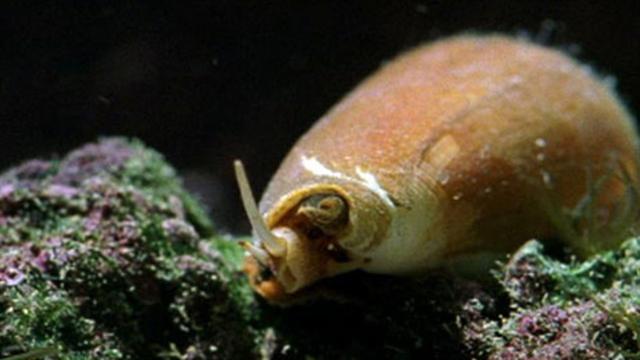The next frontier of drug research may be underwater.
President Donald Trump has officially declared the nation’s opioid crisis a national public health emergency. In November, he appointed counselor Kellyanne Conway to head efforts against it and agreed to contribute a portion of his salary to fighting it. Now, thanks to a nearly $10 million grant from the Department of Defense, researchers from the University of Utah Health are getting in on the efforts.
And this multi-disciplinary team of scientists is looking to venomous sea snails to combat the epidemic.
“Our goal is to generate a pipeline of different possibilities for non-opioid drugs,” says Toto Olivera, a biologist involved in the research. “We think that the more alternatives, the better.”
CLUES FROM THE SEA
There are hundreds of species of cone snail, a predatory marine mollusk that ranges in toxicity. For this drug research, the scientists are homing in on the subgenus Conus asprella, which includes six different species. These sea creatures hunt by injecting fish with a paralyzing venom from a harpoon-like tooth. The sea snail will hang back and observe its prey to see how it reacts to the toxic cocktail before stabbing it again and, eventually, gulping it down.
If the researchers can harness numbing ingredients of the venom that won’t hurt humans, they may be one step closer to combating the nation’s opioid crisis.
The sea snail species can grow to be an inch to an inch-and-a-half long, so their small size makes them difficult to study. But Olivera says modern technology is making it easier to investigate the defense mechanisms of these miniature mollusks. His team is also looking at the snail’s biology and behavior to deconstruct the venom’s toxic components.
“If a snail is small, it might hurt or it might paralyze your finger. But in general, it won’t be a medical emergency,” Olivera says. In the wild, a sting from a Conus asprella snail wouldn’t have much of an effect on a human, but if certain venomous toxins can be controlled, they may help in developing a new drug.
After gathering more data from analysis and animal models, the team will identify any venom components that look promising and figure out how to synthesize them to make prescription drugs. Back in February, Olivera was involved in a study that found that the venom of Conus regius snails may be an effective pain reliever in humans.
“We’re hopeful as we develop this compound,” Olivera says. “We’re hoping that we’ll be very surprised by some of the things that we find.”
NATURE’S MEDICINES
Zoltan Takacs, a biomedical scientist and National Geographic Explorer, says nature is the perfect place to find medicine. Evolution has tested defenses—including snail venom—over hundreds of millions of years to target key body functions with excellent precision.
“Venom toxins are the only molecules in the entire universe which were specially selected by nature to take a life in less than one minute,” Takacs says. “There is a huge similarity in the overall function and structure of venoms from different species. Nature took a molecule, and the same molecule is playing a role in a snake, a scorpion, and a cone snail.”
Takacs is excited for the new research. On average, it takes at least 10 years to engineer a medication out of a natural toxin—the researchers’ grant is for four years. Takacs adds the team will have to create a drug that’s effective and selective in targeting pain, which will make it more potent and reduce its side-effects. It must also be easy to administer—another drug derived from snail venom only works if it’s injected directly into the spine.
“I’m really looking forward to what they’re going to find,” Takacs says. “This is money well spent.”
A SMALL SNAIL FOR A BIG PROBLEM
Over the years, many chronic pain sufferers have turned to opioids. These pain-relieving drugs increase dopamine levels in the brain, tricking users into feeling mellow, pleasant highs.
The numbing effects of the drug make it highly addictive and lead to abuse. Overdoses from opioids cause 91 deaths in the U.S. every day, and the crisis is also hurting babies.
Thanks to technological advances, we now know more about addiction than ever before. Our bodies produce small doses of their own brand of morphine naturally to combat pain. As far as nature’s prescriptions go, snake venom could be as strong as some opiates and there’s evidence our ancestors used prehistoric aspirin. Scientists have also turned to zebrafish, who have similar neurological structures to humans, to look for answers about drug addiction.
With the sea snail research, Olivera is hoping to develop a pain-relieving drug that isn’t addictive like harmful opioids. Looking at sea snails, “we think that they have a lot of potential,” he says.
“This is a gold mine for new medications,” Takacs says.
A previous version of this story misquoted Zoltan Takacs and incorrectly stated how long medication development takes. This story has been updated.
Comment;
New alternatives to therapy for pain are always welcome. The problem however, is that these treatments won’t eliminate the genetic profile of addiction as it expresses itself in a population.
- COVID UPDATE: What is the truth? - 2022-11-08
- Pathologist Speaks Out About COVID Jab Effects - 2022-07-04
- A Massive Spike in Disability is Most Likely Due to a Wave of Vaccine Injuries - 2022-06-30


